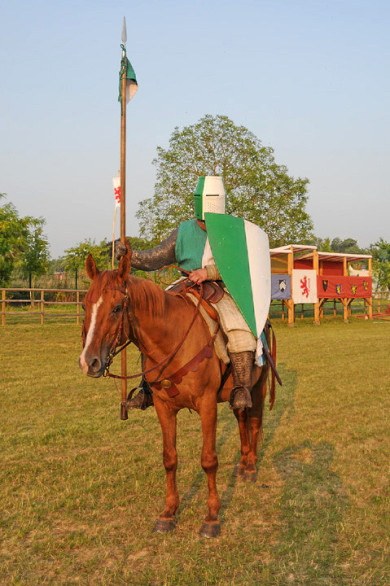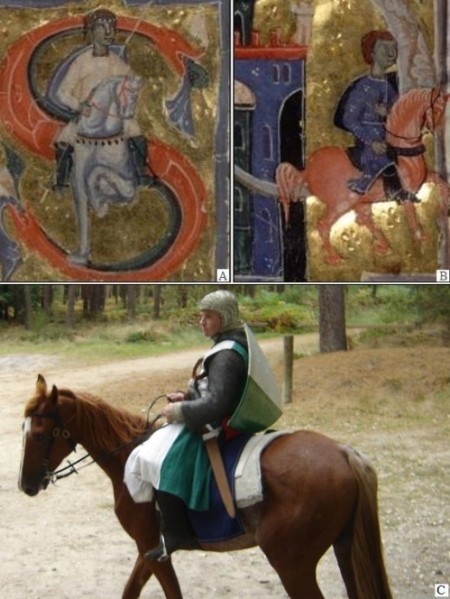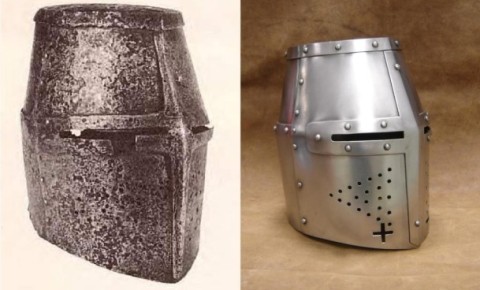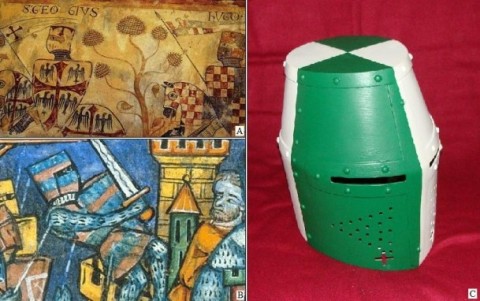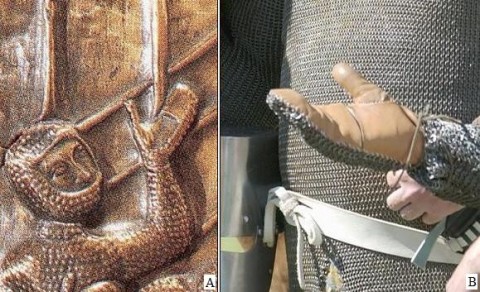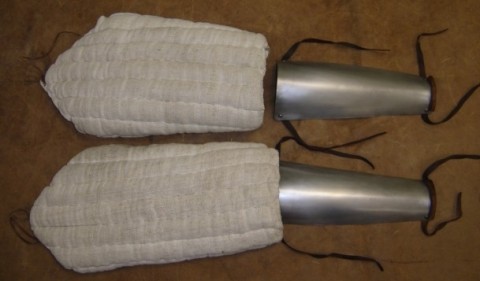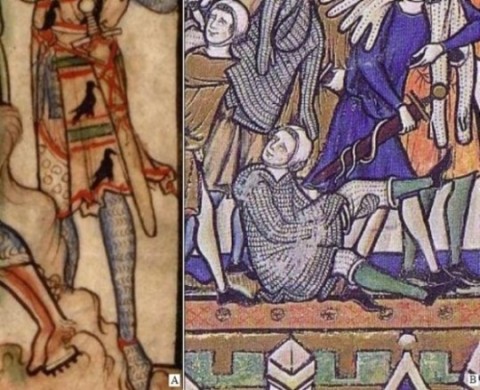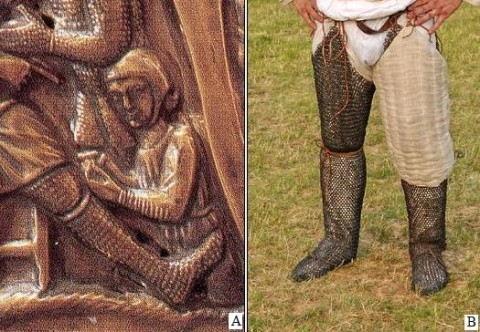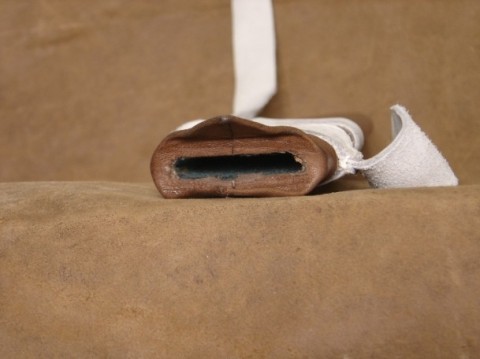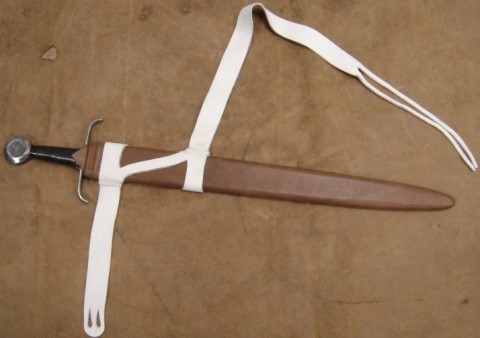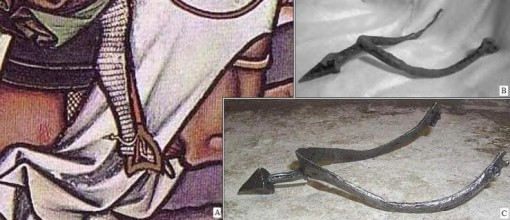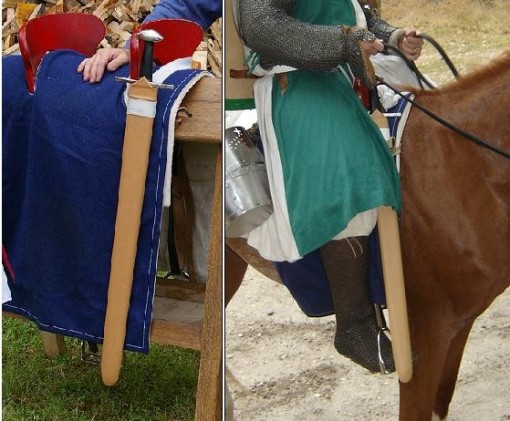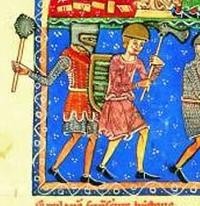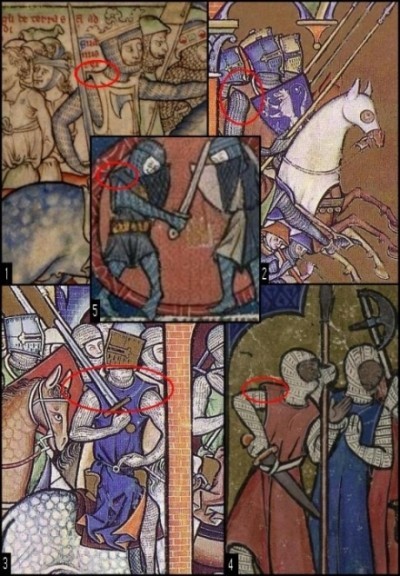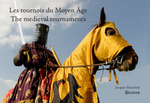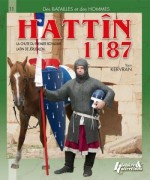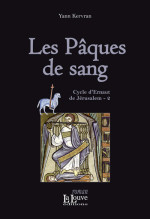French knight of the 7th Crusade
- Bernhardt de Teyssonnière -
By Bernard - Translated by Ivan
Written on 27 December 2006
Updated on 3 February 2011
Translated on 21 february 2014 by Ivan
Bernhardt de Teyssonnière (a fictional character) was born in the Viscounty of Ventadour (in the present-day Limousin region) and serves Alphonse de Poitiers (brother of King Louis IX). Like many other knights from the Limousin, he will go on to follow his lord in Egypt, at the request of the king of France, during the Seventh Crusade in 1249. The coat of arms of Bernhardt are “per pale vert and argent”. Vert (green) was rarely used as a tincture, but we have some examples from the period.
As a knight in the retinue of the Count of Poitiers, Bernhardt is well-equipped, with the full range of kit, all of good quality. He wears a gambison, a hauberk with attached mittens and hood, a surcoat bearing his coat of arms, a closed helm typical of the period, a shield, leg armour, a sword and a lance. The latter bears a simple pennon with the coat of arms, since Bernhardt is not a knight banneret.
Figure 1 : Bernhardt de Teyssonnière, armed and ready for battle.
(Photograph: Jacques Maréchal)
1- The shield
We will not describe the technical details of the fabrication of the shield, which would require an article in its own right.
1.1-The dimensions :
Following the shield proportions shown in many miniatures, paintings and sculptures dating from 1230 to 1260, we have calculated the size of the shield to be about 90 by 60 cm.
1.2-Carrying the shield :
There are two ways of carrying the shield: the usual one, held on the arm during combat, or on the back, for long journeys on foot and especially on horseback. Figures 2A et 2B clearly show this method. In figure 2C in can be seen that the angle of the shield is not exactly the same as in the miniatures. However, the shield is carried quite high, passes behind the cantle and does not touch the horse's croup. The rider and the horse are both unencumbered by the shield. To swing the shield round in the fighting position, the knight only needs to undo the buckle on the strap.
Figure 2 : A and B - Chansonnier provençal, Italy, Padua or Venice,
folio B - 52 verso and A - 60 recto, 13th century, BNF Richelieu, Paris.
C – Testing this method of carrying the shield during the seventh edition of L'Ost en Marche1.
2- The helmet
Bernhardt's helmet is a gift from his lord, and was made in Germany, which was at the time was known for the quality of its armour production. In his chronicle of the life of Saint Louis, Jean de Joinville points out that the King of France used a German sword at the Battle of Mansurah2 .
This kind of helmet offers excellent protection but considerably reduces both hearing and especially field of view. This is not a problem during mounted combat, but using such a helmet when fighting on foot would have been extremely impractical.
The helmet was painted with Bernhardt's colours, following the examples on several depictions on knights.
Figure 3 : Closed helm, Museum für Deutsche Geschichte, Berlin.
According to D. Nicolle, it dates from the mid-13th century.
On the right, a modern reproduction, based on this helmet.
Figure 4 : A – Mural painting in the church of Saint-Jacques-des-Guérets (Loir-et-cher, France).
B - Histoire d'outremer by Guillaume de Tyr, 1232-1261, British Library Yates Thomson 12.
C - Reproduction of the item painted with the colours of Bernhardt de Teyssonnière.
3- The hauberk
The hauberk is the main armour for all knights. Like many coats of mail shown in the 13th century, Bernhardt's is fitted with a mitten and a hood.
Figure 5 : A - Silver shrine of Chalemagne in Aachen Cathedral dated 1207.
B - reproduction of a mitten with a slit in the palm. (Photography: Yann Kervran)
4- Leg armour
Two options were chosen for Bernhardt's leg protection. The first is not commonly depicted in pictorial sources. The second is very frequent and thus had to be included.
4.1-Greaves and quilted thigh protection:
The first option is made up of two items: metal greaves and quilted thigh protection.
Figure 6 : Reproduction of protective equipment for the legs
made up of greaves and quilted thigh protection.
4.1.1- The greaves:
The greaves are made of simple metal plates, attached by leather thongs tied behind the calf, and must be made to measure (or they would be extremely uncomfortable and could even injure the wearer). Once worn, they cause no discomfort either on horseback or during dismounted combat (this has been tested several times). They also provide excellent protection.
Although they were quite rare in the mid-13th century, we still find some examples in contemporary miniatures, as can be seen on figures 7A and 7B. Regarding this item of equipment, the example of Goliath (whose legs can be seen on the right in this figure) is the subject of debate in the historical interpretation community. One view is that these greaves could simply be artistic imagination, following the description in the Bible passage describing the incident shown in the miniature. However, none of the period depictions of Goliath which we have examined show such greaves, even though the Biblical text remained unchanged during this period. We therefore conclude that the “Maciejowski Bible” is either the only only which is faithful to the Biblical text, or that it shows an item of armour which existed in the mid-13th century. Since Goliath was a formidable warrior, it is possible that the artist chose to depict him wearing the best modern equipment available at the time.
Figure 7 : A - Lives of the Offas, folio 7, by Matthew Paris, c. 1250, British Library, London.
B - Maciejowski Bible, folio 27 verso, France, mid-13th century, Pierpont Morgan Library, New York.
4.1.2- Quilted thigh protection :
The quilted thigh protectors are made of linen stuffed with wool fibres, with the filling kept in place by vertical stitching. Like the hose, they are tied on by a pair of leather thongs attached to the breeches. Additional laces were added behind the knees to keep the protectors in place. We have a few examples of metal knee plates in the mid-13th century, but we decided not to include them. Like the greaves, the thigh protectors are very comfortable to wear, both on foot and on horseback.
Figure 8 : A - The Life of King Edward the Confessor, folio 05 verso
Angleterre, mi-XIIIe, Cambridge University Library.
B - Maciejowski Bible, folio 3 verso, France,
mid-13th century, Pierpont Morgan Library, New York.
4.2- Mail chausses :
The second possibility is to wear mail chausses. Since they are very common in depictions of knights during this period, we have chosen to provide Bernhardt with a pair. They are made to the same pattern as fabric chausses (or hose) and are worn over a pair of thick linen hose. Since they are too heavy to attach to the drawstring for the breeches, they are suspended from a belt worn over the the latter and under the gambison. Following some pictorial sources3 (see figure 8), quilted thigh armour or even metal greaves can be additionally worn (see figure 7A).
Figure 9 : A - Silver shrine of Chalemagne in Aachen Cathedral datée de 1207.
B - Reproduction of a pair of mail chausses with or without the quilted
thigh protectors. The lacing under the knee is needed to keep
the mail chausse in place. (Photography: Jacques Maréchal)
5- Scabbard and sword belt
The scabbard is made of two sheets of wood, carved and cut to the shape of the sword. Once joined together, the sheets are covered in goatskin leather, which is glued on. The inside is covered in lightly-oiled wool in order to protect the blade from moisture.
Figure 10 : The scabbard end-on, with the inside covered in wool.
The sword belt was cut out of cowskin leather. The straps are fixed to the scabbard in an inverted Z-shape, which can be seen in many sources. The sword belt is tied by means of a knot in the split end. This method is very common in pictorial sources throughout the 13th century (see figure 13) but belt buckles were also used (and perhaps they would have been more common in Bernhardt's home region).
Figure 11 : A - Scabbard for the sword of Sancho IV of Castile, 1285-90.
B - Reconstructed item.
Figure 12 : View of the complete scabbard and sword belt with split end.
Figure 13 : France, mid-13th century, Pierpont Morgan Library, New York.
B - Life of Saint Denis, folio 39 verso, France, mid-13th century, BNF, Paris.
6- The spurs
Like all knights, Bernhardt de Teyssonnière wears spurs, which had a symbolic as well as practical function (he could not ride into battle without them). Rowel spurs already existed at the time, but it appears that the vast majority of horsemen wore simple prick spurs, which are an older design. (Note: Such spurs require a good level of horsemanship to avoid injuries to the horse.)
Figure 14 : Prick spurs reconstructed by Raymond’s Quiet Press.
Figure 15 : A - Maciejowski Bible, folio 10 verso,
France, mid-13th century, Pierpont Morgan Library, New York.
B - German spur 1150-1225.
C - French spur dating from the early 13th century.
7- The saddle sword
Jean de Joinville describes how he used a sword attached to his saddle during combat against the Egyptians4. The Speculum regalae5 advises cavalrymen to carry a sword hung from the saddle pommel. Bernhardt therefore carries such a sword a attached to his saddle.
Figure 16 : A – Saddle sword attached to the pommel on the saddle.
B - During the seventh edition of “Ost en Marche”, the sword attached
in this way did not hinder the rider or the horse, whatever the riding position.
8- Work in progress
The next item of equipment to be made for Bernhardt will be a reinforced surcoat. This is an interpration of three different sources:
- Jean de Joinville chronicles, in which he describes Saint Louis as wearing a surcoat made of reinforced silk taffeta6 ;
- the `Speculum regalae', in which the author specifies that a thick gambison must be worn over the mail hauberk during combat;
- figure 17, in which the subject appears to be wearing a quilted garment over the mail coat. Regarding this source, David Nicolle suggests a coat of plate armour.
Figure 17 : Beatus commentaries on the Apocalypse, Catalogne, 1190-1225,
Nouv. Acq. Lat. 2290, Bibliothèque Nationale, Paris.
Various pictorial sources show warriors wearing surcoats which appear to be rigid around the shoulder area (see figure 14). This is not definite proof of a reinforced surcoat but such a surcoat would be a possible explanation. David Nicolle's hypotheses are that this could be either a quilted surcoat, or a surcoat reinforced with leather, but the `Speculum regalae' mentioned above hints at the former being more probable.
Figure 18 : Several depictions of “rigid” surcoats.
1 - The Life of King Edward the Confessor, mid-13th century.
2 & 3 - Maciejowski Bible, mid-13th century.
4 - The Murthly Hours 1280. 5 - Lancelot of the Lake, 13th century.
1 – “l'Ost en Marche” is an event organised by Philippe Rudrauf whose aim is to test reconstructed historical equipment in real marching conditions. Site internet : http://ostenmarche.com/
2 - “Vie de Saint Louis” by Jean de Joinville § 228, Livre de poche edition.
3 – See figure 8 or “The king's mirror (Speculum regalae – Konugs skuggsjá) translated from the old norwegian” by Laurence Marcellus Larson, New York, 1917. Chapter XXXVIII, page 219.
4 - “Vie de Saint Louis” by Jean de Joinville § 221, Livre de poche edition.
5 - “The king's mirror (Speculum regalae – Konugs skuggsjá) translated from the old norwegian” by Laurence Marcellus Larson, New York, 1917. Chapter XXXVIII, page 219.
6 - “Vie de Saint Louis” by Jean de Joinville § 25, Livre de poche edition.

